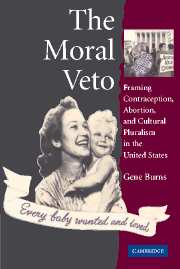Book contents
- Frontmatter
- Contents
- Acknowledgments
- 1 Introduction
- 2 Framing Contraception within Moral Worldviews: The Early, Radical Birth Control Movement
- 3 The Mainstreaming of Birth Control: A New Alliance with Eugenics and Medicine
- Dennett's Moral Worldview and the Catholic Moral Veto: Unsuccessful Frames for Contraception
- 5 Abortion before Controversy: Quiet Reform within a Medical, Humanitarian Frame
- 6 Abortion and Legislative Stalemate: The Weakness and Strength of the Medical, Humanitarian Frame
- 7 Looking Back: Limiting Frames, Moral Vetoes, and Cultural Pluralism
- Works Cited
- Index
3 - The Mainstreaming of Birth Control: A New Alliance with Eugenics and Medicine
Published online by Cambridge University Press: 21 July 2009
- Frontmatter
- Contents
- Acknowledgments
- 1 Introduction
- 2 Framing Contraception within Moral Worldviews: The Early, Radical Birth Control Movement
- 3 The Mainstreaming of Birth Control: A New Alliance with Eugenics and Medicine
- Dennett's Moral Worldview and the Catholic Moral Veto: Unsuccessful Frames for Contraception
- 5 Abortion before Controversy: Quiet Reform within a Medical, Humanitarian Frame
- 6 Abortion and Legislative Stalemate: The Weakness and Strength of the Medical, Humanitarian Frame
- 7 Looking Back: Limiting Frames, Moral Vetoes, and Cultural Pluralism
- Works Cited
- Index
Summary
Introduction
The current chapter continues Chapter 2's examination of the social and political context for the framing of contraception. It does so by focusing especially on the reframing of contraception away from its radical roots toward a more strategically effective frame. This chapter aims to make two central points. First, it tries to demonstrate that different kinds of frames are more or less likely depending on who is included and who is excluded from a debate. For example, it is quite easy for all those publicly involved in a debate to ignore the concerns of, and even to denigrate, those not involved. The contraception debate included frequent derogatory references to supposedly inferior qualities of African Americans and recent immigrants, groups who had little voice within the politics of the time. Eugenic perspectives – that is, concern that the quality of the population – often assumed, without challenge, that American society would decline if such “inferior” peoples reproduced too quickly relative to native-born, white Protestants. Even at times when eugenics was probably not particularly strategically effective in building support for contraception, eugenic frames of contraception survived, because those involved in the debate had so little connection to those parts of the population that were denigrated by eugenic arguments.
But even the meaning of eugenics depended upon who was involved in the debate at a given time.
- Type
- Chapter
- Information
- The Moral VetoFraming Contraception, Abortion, and Cultural Pluralism in the United States, pp. 69 - 105Publisher: Cambridge University PressPrint publication year: 2005



